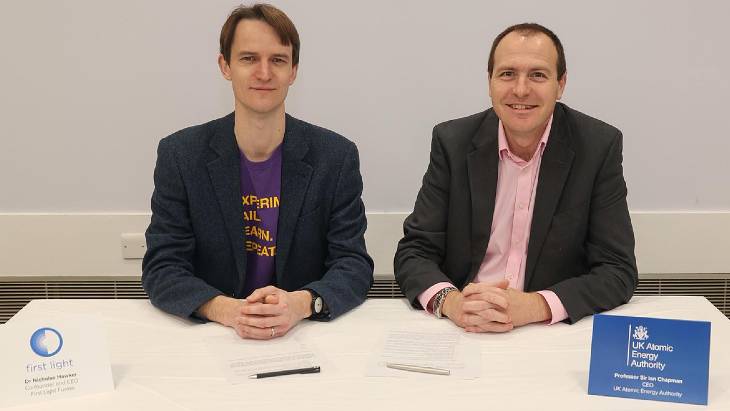Nuclear fusion is the process by which two light nuclei combine to form a single heavier nucleus, releasing a large amount of energy. First Light's method uses the same physics proven last month by the National Ignition Facility (NIF) at Lawrence Livermore National Laboratory in the USA, but "combines it with a unique approach which involves firing a projectile at a fuel pellet to force it to fuse and produce energy".
Machine 4 is not intended to generate power, but will help to develop technology needed for future inertial confinement fusion energy power plants. First Light said it will "have a stored electrical energy of c.100 mega joules with the capability of launching projectiles at 60kms per second. This speed on impact inside the target will accelerate to c.200kms per second as a result of First Light’s exclusive amplifier technology. The amplifier focuses the energy of the projectile into the fusion fuel, both boosting the pressure from impact to deliver to the fuel and shaping the waves to produce spherical implosions". Its current Machine 3 launches a projectile at c.20 kms per second.
First Light said that locating the demonstrator at the Culham Campus will bring benefits from UKAEA's expertise and the supply chain infrastructure.
Nick Hawker, co-founder and CEO of First Light Fusion, said: "With this agreement in place, and contracts signed with designers and architects, we can accelerate our development timeframe. The recent gain result from the National Ignition Facility in California proved what we always knew - that inertial confinement fusion works and offers the potential for a faster route to commercial fusion. It also had considerable positive repercussions for us at First Light. Our approach leverages the same physics now proven by NIF but combines it with a unique approach that gets to a competitive cost point in a truly scalable manner. We’ve already proven fusion. Gain is our next milestone. We are very confident Machine 4 will allow us to achieve this, while we continue to develop plans for a pilot commercial fusion powerplant."
Ian Chapman, CEO of UKAEA, said: "We have enjoyed a long relationship with First Light Fusion as it has progressed its unique projectile fusion method, and worked with them to validate their maiden fusion result in 2022. First Light joins other fusion pioneers in working at Culham as we continue to drive UK economic growth and a thriving fusion industry."
Technical building design specialists Ramboll and architects Scott Brownrigg have been appointed. With construction aiming to start in 2024 the timeline is for operations to commence as early as 2027.
Inertial confinement is one of two main experimental approaches to nuclear fusion that are currently being studied. Magnetic confinement fusion uses strong magnetic fields to contain the hot plasma in a containment such as a tokamak.
There are a number of fusion facilities sited at, or planned, for the UKAEA's Culham facility. Earlier this month South Oxfordshire District Council planning committee gave the go ahead for construction of Canada-based General Fusion's Fusion Demonstration Plant on the same campus. The 10,500-square-metre building will house the fusion machine which is expected to be commissioned in 2026.
Another UK-based fusion firm, Tokamak Energy, intends to build a fusion demonstrator by 2026, with a prototype fusion plant in the "early 2030s". Construction is proposed to begin in 2024 although a site has not been finalised, with the comapny telling World Nuclear News in November that its current facility in Oxfordshire - not far from the UKAEA campus - was not large enough and it was considering other options within the same area.
The UKAEA carries out fusion energy research on behalf of the UK government, overseeing the country's fusion programme, including the MAST Upgrade (Mega Amp Spherical Tokamak) experiment as well as hosting the JET - Joint European Tourus - at Culham, which is operated for scientists from around Europe.
UKAEA is developing its own fusion power plant design with plans to build a prototype known as STEP (Spherical Tokamak for Energy Production) at West Burton in Nottinghamshire, which is due to begin operating by 2040.







_53514_33880.jpg)






